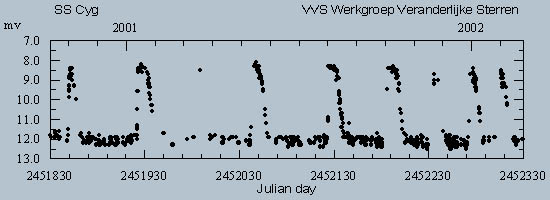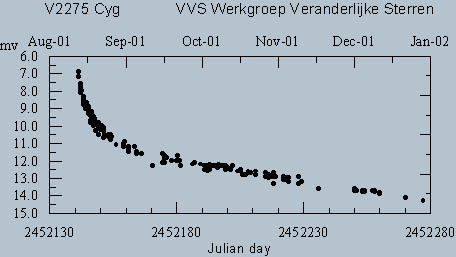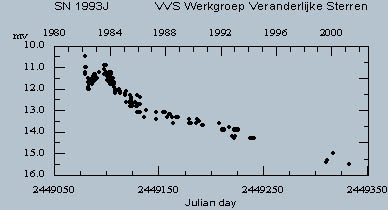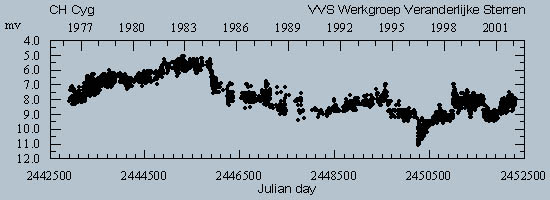Cataclysmic variables are explosive stars. These stars thus show sudden outburts. To this group belong:
Dwergnovae
Here, we are always dealing with a very close binary system. Matter is for example being transferred from a cool, large star to a white dwarf. This matter first settles in an orbit around the white dwarf and forms a disc, the accretion disc. From time to time, more mass is transferred through the disc to the white dwarf. This liberates a enormous amount of energy. We observe this as a sudden and spectacular increase in brightness.

Novae
This class of variables also consists of close binaries. Similar to dwarfnovae, mass is being transferred from a cool, large star to a hot white dwarf. When enough mass is collected on the surface of the white dwarf, nuclear fusion takes place and the star suddenly goes in outburst. After the maximum, the stars faints during a period of weeks or months to its original brightness.

Supernovae
There are two kinds of supernovae, designated as type I and type II. A type II supernova
is the end of a very heavy star. Such stars continue their nuclear fusion processes until iron is formed in
the core. Because iron can no longer start nuclear fusion that delivers necessary energy, the core collapses.
This liberates a tremendous amount of energy so that the brightness of a supernova can compete with the brightness
of a whole galaxy. The outer layers of the star are blown away into space.
A type I supernova probably emerges from a close binary system in which one of the components is a white dwarf.
A white dwarf is the end product of a star whose mass is lower the 8 solar masses. These are small and hot remnants
that consist of carbon and oxygen. The mass of such a white dwarf does not exceed the Chandrasekhar limit, namely
1.4 solar masses. In case a little extra amount of mass is added, the white dwarf collapses. This liberates
a large amount of energy and causes the system to brighten spectacularly. The mass that pushes the white dwarf
over the Chandrasekhar limit comes from the companion.

Symbiotic variables
These stars are also called Z Andromedae stars. It is a rather heterogeneous group of close binaries that exist of a hot and an old star. This system is embedded in an enveloppe of gas that, due to the radiation of the hot star, starts to shine itself. This combined brightness shows complex irregular variations.
